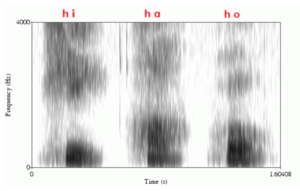Acoustic Phonetics (definition)
Acoustic phonetics is the study of the physical properties of speech sounds; these include frequency, amplitude, pitch, etc. Because they exist in a continuous space, vowels are more reliably described with their acoustic features than the movement of articulators. Vowels are normally characterized by the format frequencies (F1, F2, F3) intrinsic to the shape of the vocal tract that creates a particular vocal sound; the source-filter model is often used to explore this phenomenon. Formant frequencies and other physical speech cues like frication, aspiration, and voicing can be analyzed by their waveforms or spectrograms.
This subfield of phonetics in particular is vital to developing speech technologies that interpret and reproduce the human speech stream.
See also
External Links
- http://www.asel.udel.edu/speech/tutorials/index.html
- http://www.ic.arizona.edu/~lsp/Phonetics/Acoustics/Acoustics.html
- https://all-about-linguistics.group.shef.ac.uk/branches-of-linguistics/phonetics/what-do-phoneticians-study/acoustic-phonetics/
- https://home.cc.umanitoba.ca/~krussll/phonetics/acoustic/spectrogram-sounds.html
- https://www.mq.edu.au/about/about-the-university/faculties-and-departments/medicine-and-health-sciences/departments-and-centres/department-of-linguistics/our-research/phonetics-and-phonology/speech/acoustics/acoustic-theory-of-speech-production/source-filter-theory#:~:text=The%20source%2Dfilter%20theory%20describes,properties%20of%20the%20vocal%20tract.&text=Sound%20sources%20can%20be%20either%20periodic%20or%20aperiodic.
The link below takes you away from the Gaelic Wiki to Wikipedia. Since wikipedia pages can be edited by anyone, they often contain inaccurate information. So be careful!
